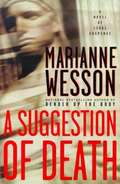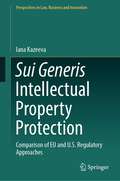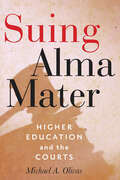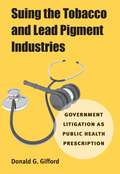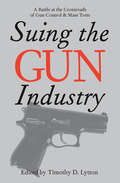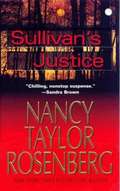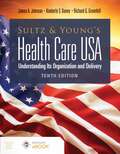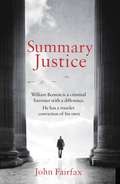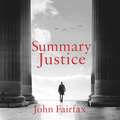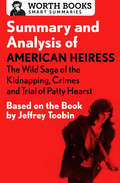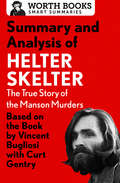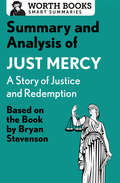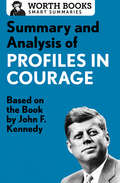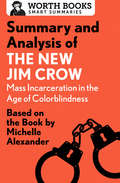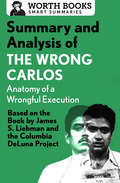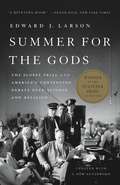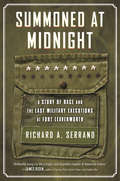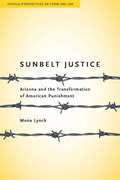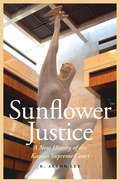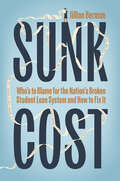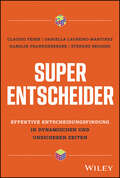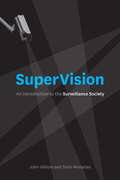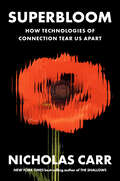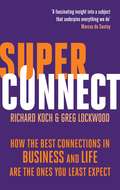- Table View
- List View
Suggestion of Death
by Marianne WessonIn her national bestseller Render Up the Body, former federal prosecutor Marianne Wesson delivered an "intense legal drama". Now, Wesson's unforgettable heroine, Colorado attorney Cinda Hayes, is the heart and soul of a thrilling and authentic new novel -- a page-turner that ranks with the best suspense fiction of Scott Turow and Linda Fairstein.
Sui Generis Intellectual Property Protection: Comparison of EU and U.S. Regulatory Approaches (Perspectives in Law, Business and Innovation)
by Iana KazeevaThe standard forms of intellectual property protection, namely, copyright, patents, trademarks and trade secrets, have a long history and are well regulated in the legislative systems of most jurisdictions. However, there are specific kinds of subject matter that, due to their characteristics, cannot be adequately protected by these standard forms of intellectual property instruments. At the same time, these categories of subject matter require legal protection in order to ensure the balance between the public's access to these creations and the creators' rights. For these reasons, many jurisdictions introduce a special form of intellectual property protection, namely, sui generis regime, i.e., intellectual property legal regime “of its own kind”, designed to serve the specific needs of a particular subject matter. This book analyzes the intellectual property protection regimes in the EU and the U.S. available for three categories of subject matter that are often considered as requiring sui generis protection, namely, databases, designs and plant varieties. One of the main objectives is to evaluate whether the chosen subject matter in fact requires sui generis intellectual property protection and whether the introduced sui generis regimes have proved to be successful over time. The final chapter of this book analyses the perspectives of sui generis intellectual property protection for works generated by AI systems. This volume offers a comprehensive analysis of sui generis intellectual property rights and will be a key source for both scholars and practitioners with an interest in intellectual property law.
Suing Alma Mater: Higher Education and the Courts
by Michael A. OlivasThis careful reading of six legal cases in American higher education is an essential primer for understanding contemporary litigation.Winner of the Steven S. Goldberg Award for Distinguished Scholarship in Education Law of the Education Law AssociationAlthough much has been written about U.S. Supreme Court decisions involving higher education, little has been said about the foundational case law and litigation patterns emerging from the lower courts. As universities become increasingly legislated, regulated, and litigious, campuses have become testing grounds for a host of constitutional challenges. From faculty and student free speech to race- or religion-based admissions policies, Suing Alma Mater describes the key issues at play in higher education law.Eminent legal scholar Michael A. Olivas considers higher education litigation in the latter half of the twentieth century and the rise of "purposive organizations," like the American Civil Liberties Union and the Alliance Defense Fund (now known as the Alliance Defending Freedom), that exist to advance litigation. He reviews more than 120 college cases brought before the Supreme Court in the past fifty years and then discusses six key cases in depth. Suing Alma Mater provides a clear-eyed perspective on the legal issues facing higher education today.
Suing The Tobacco And Lead Pigment Industries
by Donald G. Gifford"The topic, how tort law evolved over time into a system that allowed, for a moment at least, a parens patriae form of massive litigation against corporations, is exceedingly interesting and important. Gifford's treatment of this topic is highly informative, engaging, insightful, very current, and wise. " ---David Owen, Carolina Distinguished Professor of Law, and Director of Tort Law Studies, University of South Carolina InSuing the Tobacco and Lead Pigment Industries, legal scholar Donald G. Gifford recounts the transformation of tort litigation in response to the challenge posed by victims of 21st-century public health crises who seek compensation from the product manufacturers. Class action litigation promised a strategy for documenting collective harm, but an increasingly conservative judicial and political climate limited this strategy. Then, in 1995, Mississippi attorney general Mike Moore initiated aparens patriaeaction on behalf of the state against cigarette manufacturers. Forty-five other states soon filed public product liability actions, seeking both compensation for the funds spent on public health crises and the regulation of harmful products. Gifford finds that courts, through their refusal to expand traditional tort claims, have resisted litigation as a solution to product-caused public health problems. Even if the government were to prevail, the remedy in such litigation is unlikely to be effective. Gifford warns, furthermore, that by shifting the powers to regulate products and to remediate public health problems from the legislature to the state attorney general,parens patriaelitigation raises concerns about the appropriate allocation of powers among the branches of government. Donald G. Gifford is the Edward M. Robertson Research Professor of Law at the University of Maryland School of Law.
Suing the Gun Industry: A Battle at the Crossroads of Gun Control and Mass Torts
by Timothy D. Lytton"Mass tort litigation against the gun industry, with its practical weaknesses, successes, and goals, provides the framework for this collection of thoughtful essays by leading social scientists, lawyers, and academics. . . . These informed analyses reveal the complexities that make the debate so difficult to resolve. . . . Suing the Gun Industry masterfully reveals the many details contributing to the intractability of the gun debate. " -New York Law Journal "Second Amendment advocate or gun-control fanatic, all Americans who care about freedom need to readSuing the Gun Industry. " -Bob Barr, Member of Congress, 1995-2003, and Twenty-First Century Liberties Chair for Freedom and Privacy, American Conservative Union "Thesource for anyone interested in a balanced analysis of the lawsuits against the gun industry. " -David Hemenway, Professor of Health Policy & Director, Harvard Injury Control Research Center Harvard School of Public Health Health Policy and Management Department, author ofPrivate Guns, Public Health "Highly readable, comprehensive, well-balanced. It contains everything you need to know, and on all sides, about the wave of lawsuits against U. S. gun manufacturers. " -James B. Jacobs, Warren E. Burger Professor of Law and author ofCan Gun Control Work? "InSuing the Gun Industry, Timothy Lytton has assembled some of the leading scholars and advocates, both pro and con, to analyze this fascinating effort to circumvent the well-known political obstacles to more effective gun control. This fine book offers a briefing on both the substance and the legal process of this wave of lawsuits, together with a better understanding of the future prospects for this type of litigation vis-à-vis other industries. " -Philip J. Cook, Duke University "An interesting collection, generally representing the center of the gun-control debate, with considerable variation in focus, objectivity, and political realism. " -Paul Blackman, retired pro-gun criminologist and advocate Gun litigation deserves a closer look amid the lessons learned from decades of legal action against the makers of asbestos, Agent Orange, silicone breast implants, and tobacco products, among others. Suing the Gun Industrycollects the diverse and often conflicting opinions of an outstanding cast of specialists in law, public health, public policy, and criminology and distills them into a complete picture of the intricacies of gun litigation and its repercussions for gun control. Using multiple perspectives,Suing the Gun Industryscrutinizes legal action against the gun industry. Such a broad approach highlights the role of this litigation within two larger controversies: one over government efforts to reduce gun violence, and the other over the use of mass torts to regulate unpopular industries. Readers will findSuing the Gun Industrya timely and accessible picture of these complex and controversial issues. Contributors: Tom Baker Donald Braman Brannon P. Denning Tom Diaz Howard M. Erichson Thomas O. Farrish Shannon Frattaroli John Gastil Dan M. Kahan Don B. Kates Timothy D. Lytton Julie Samia Mair Richard A. Nagareda Peter H. Schuck Stephen D. Sugarman Stephen Teret Wendy Wagner
Sullivan's Justice
by Nancy Taylor RosenbergProbation officer Carolyn Sullivan's brother discovers the body of his girlfriend in his swimming pool, and soon he's the prime suspect.
Sultz and Young's Health Care USA: Understanding Its Organization and Delivery
by James A. Johnson Kimberly S. Davey Richard G. GreenhillCombining historical perspective with analysis of current trends, Sultz & Young's Health Care USA, Tenth Edition charts the evolution of modern American health care, providing a complete examination of its organization and delivery while offering critical insight into the issues that the U.S. health system faces today.Building on the legacy of its prior successful editions, new co-authors James Johnson, Kim Davey, and Richard Greenhill lend their deep expertise in health services planning, administration, quality assessment, and teaching to the Tenth Edition by providing an updated, wide-ranging, and timely view of today's health care delivery system. New! Health systems thinking perspective is used as the organizing framework throughout, addressing a core Council on Education for Public Health (CEPH) competency. New chapters address important aspects of the U.S. health system such as Public Policy and the Role of Government in Health Care (3); Health Services and System Research (12); Preparedness and Emergency Management (13); and Rural Health (14).New assignments, cases, and interviews engage learners and encourage better comprehension of concepts and issues.New appendix provides an in-depth analysis of the Canadian health system to help learners identify the similarities and differences between the U.S. and Canadian health systems. All chapters were revised and updated to reflect current developments and trends in the field such as the COVID-19 pandemic, diversity, equity, and inclusion, artificial intelligence, machine learning, and much more. A final chapter explores innovation in technology, workforce trends, and other challenges and opportunities facing the U.S. health system. Upper-level undergraduate and graduate courses covering the U.S. health care system in a wide range of health-oriented degree programs: Health Care Administration, Business, Nursing, Health Science, Pharmacy, Physical Therapy, Public Health and Public Administration. Courses include: Health Care Delivery Systems Intro to the US Healthcare System Health Care in America Healthcare Organization and Administration Current Issues/Contemporary Environment in Health Care © 2023 | 475 pages
Summary Justice: 'An all-action court drama' Sunday Times (Benson and De Vere)
by John FairfaxThe last time Tess de Vere saw William Benson she was a law student on work experience. He was a twenty-one year old, led from the dock of the Old Bailey to begin a life sentence for murder. He'd said he was innocent. She'd believed him.Sixteen years later Tess overhears a couple of hacks mocking a newcomer to the London Bar, a no-hoper with a murder conviction, running his own show from an old fishmonger's in Spitalfields. That night she walks back into Benson's life. The price of his rehabilitation - and access to the Bar - is an admission of guilt to the killing of Paul Harbeton, whose family have vowed revenge. He's an outcast. The government wants to shut him down and no solicitor will instruct him. But he's subsidised by a mystery benefactor and a desperate woman has turned to him for help: Sarah Collingstone, mother of a child with special needs, accused of slaying her wealthy lover. It's a hopeless case and the murder trial, Benson's first, starts in four days. The evidence is overwhelming but like Benson long ago, she swears she's innocent. Tess joins the defence team, determined to help Benson survive. But as Benson follows the twists and turns in the courtroom, Tess embarks upon a secret investigation of her own, determined to uncover the truth behind the death of Paul Harbeton on a lonely night in Soho.True to life, fast-paced and absolutely compelling, Summary Justice introduces a new series of courtroom dramas featuring two maverick lawyers driven to fight injustice at any cost.
Summary Justice: 'An all-action court drama' Sunday Times (Benson and De Vere)
by John FairfaxThe last time Tess de Vere saw William Benson she was a law student on work experience. He was a twenty-one year old, led from the dock of the Old Bailey to begin a life sentence for murder. He'd said he was innocent. She'd believed him.Sixteen years later Tess overhears a couple of hacks mocking a newcomer to the London Bar, a no-hoper with a murder conviction, running his own show from an old fishmonger's in Spitalfields. That night she walks back into Benson's life. The price of his rehabilitation - and access to the Bar - is an admission of guilt to the killing of Paul Harbeton, whose family have vowed revenge. He's an outcast. The government wants to shut him down and no solicitor will instruct him. But he's subsidised by a mystery benefactor and a desperate woman has turned to him for help: Sarah Collingstone, mother of a child with special needs, accused of slaying her wealthy lover. It's a hopeless case and the murder trial, Benson's first, starts in four days. The evidence is overwhelming but like Benson long ago, she swears she's innocent. Tess joins the defence team, determined to help Benson survive. But as Benson follows the twists and turns in the courtroom, Tess embarks upon a secret investigation of her own, determined to uncover the truth behind the death of Paul Harbeton on a lonely night in Soho.True to life, fast-paced and absolutely compelling, Summary Justice introduces a new series of courtroom dramas featuring two maverick lawyers driven to fight injustice at any cost.
Summary and Analysis of American Heiress: Based on the Book by Jeffrey Toobin
by Worth BooksSo much to read, so little time? This brief overview of American Heiress tells you what you need to know--before or after you read Jeffrey Toobin's book. Crafted and edited with care, Worth Books set the standard for quality and give you the tools you need to be a well-informed reader. This short summary and analysis of American Heiress by Jeffrey Toobin includes: Historical contextChapter-by-chapter summariesDetailed timeline of key eventsProfiles of the main charactersImportant quotesFascinating triviaGlossary of termsSupporting material to enhance your understanding of the original work About American Heiress by Jeffrey Toobin: Bestselling author Jeffrey Toobin's American Heiress is a thorough true crime account of the kidnapping and trial of Patty Hearst, whose sensational journey gripped the nation and defined a tumultuous period in American history. On February 4, 1974, Patricia Hearst--the heiress to the Hearst family fortune--was abducted by a group of left-wing revolutionaries called the Symbionese Liberation Army (SLA). What started as a media sensation turned into a circus when a recording was released in which Patty claimed she was joining the movement and her new name was Tania. Set against the backdrop of an already turbulent era, and based on hundreds of interviews and never-before-seen documents, American Heiress is a revelatory look at one of the most famous abductions of the twentieth century. The summary and analysis in this ebook are intended to complement your reading experience and bring you closer to a great work of nonfiction.
Summary and Analysis of Helter Skelter: Based on the Book by Vincent Bugliosi with Curt Gentry (Smart Summaries)
by Worth BooksSo much to read, so little time? This brief overview of Helter Skelter tells you what you need to know—before or after you read Vincent Bugliosi and Curt Genry&’s book. Crafted and edited with care, Worth Books set the standard for quality and give you the tools you need to be a well-informed reader. This summary of Helter Skelter by Vincent Bugliosi with Curt Gentry includes: Historical contextSection-by-section overviewsDetailed timeline of eventsAnalysis of the main charactersFascinating triviaGlossary of termsSupporting material to enhance your understanding of the original work About Vincent Bugliosi and Curt Gentry&’s Helter Skelter: In the bestselling true crime book Helter Skelter, lead prosecutor Vincent Bugliosi provides a meticulously detailed account of the murders committed by the Manson family and their trial—one of the most sensational criminal cases of the century. From the police investigation of the murders of Leno and Rosemary LaBianca and Sharon Tate, to the arrests, the courtroom antics, and the personalities and motivations of Charles Manson and his followers, Helter Skelter offers a haunting look into the horrific repercussions of cult mentality on a violent rampage. The summary and analysis in this ebook are intended to complement your reading experience and bring you closer to a great work of nonfiction.
Summary and Analysis of Just Mercy: Based on the Book by Bryan Stevenson
by Worth BooksSo much to read, so little time? This brief overview of Just Mercy: A Story of Justice and Redemption tells you what you need to know—before or after you read Bryan Stevenson book. Crafted and edited with care, Worth Books set the standard for quality and give you the tools you need to be a well-informed reader. This short summary and analysis of Just Mercy includes: Historical contextChapter-by-chapter overviewsCharacter profilesDetailed timeline of key eventsImportant quotes and analysisFascinating triviaGlossary of termsSupporting material to enhance your understanding of the original work About Just Mercy: A Story of Justice and Redemption by Bryan Stevenson: Just Mercy is a heartbreaking—but not entirely hopeless—look inside the American criminal justice system. The guide on this journey to death row, judges’ chambers, and courthouses small and large is Bryan Stevenson, one of the country’s foremost criminal justice reformers and the founder of the Equal Justice Initiative, the acclaimed legal aid organization based in Montgomery, Alabama. In Stevenson’s chronicle, the only thing standing between death or life imprisonment is an underpaid, overworked lawyer. The summary and analysis in this ebook are intended to complement your reading experience and bring you closer to a great work of nonfiction.
Summary and Analysis of Profiles in Courage: Based on the Book by John F. Kennedy (Smart Summaries)
by Worth BooksSo much to read, so little time? This brief overview of Profiles in Courage tells you what you need to know—before or after you read John F. Kennedy&’s book. Crafted and edited with care, Worth Books set the standard for quality and give you the tools you need to be a well-informed reader. This short summary and analysis of Profiles in Courage includes: Historical contextChapter-by-chapter overviewsProfiles of the main charactersDetailed timeline of key eventsImportant quotesFascinating triviaGlossary of termsSupporting material to enhance your understanding of the original work About Profiles in Courage by John F. Kennedy: John F. Kennedy&’s Profiles in Courage takes an in-depth look at eight US senators who displayed courage by going against their political party&’s platform and acting on integrity and convictions. These timeless stories of political courage and inner strength are no less poignant today than upon the book&’s original publication in 1955. The summary and analysis in this ebook are intended to complement your reading experience and bring you closer to a great work of nonfiction.
Summary and Analysis of The New Jim Crow: Based on the Book by Michelle Alexander
by Worth BooksSo much to read, so little time? This brief overview of The New Jim Crow tells you what you need to know--before or after you read Michelle Alexander's book. Crafted and edited with care, Worth Books set the standard for quality and give you the tools you need to be a well-informed reader. This short summary and analysis of The New Jim Crow by Michelle Alexander includes: Historical context Chapter-by-chapter summaries Detailed timeline of key events Profiles of the main characters Important quotes Fascinating trivia Glossary of terms Supporting material to enhance your understanding of the original work About The New Jim Crow by Michelle Alexander: Legal scholar and civil rights lawyer Michelle Alexander's invaluable and timely work, The New Jim Crow, examines what she calls the new racial caste system in United States: mass incarceration. Following the practices of slavery and institutional discrimination, Alexander argues, mass incarceration is part of America's legacy to dehumanize and disenfranchise African Americans and Latinos. According to Alexander, "we have not ended racial caste in America; we have merely redesigned it." Thanks in a large part to the War on Drugs, more than two million people are in America's prisons today--an overwhelming majority of them are people of color who've been jailed for minor drug charges. When these adults leave prison, they are often denied employment, housing, the right to vote, and a quality education. As a result, they are rarely able to integrate successfully into society. The New Jim Crow is a well-argued call to dismantle a system of policies that continues to deny civil rights, decades after the passing of the Civil Rights and Voting Rights Acts. The summary and analysis in this ebook are intended to complement your reading experience and bring you closer to a great work of nonfiction.
Summary and Analysis of The Wrong Carlos: Based on the Book by James S. Liebman
by Worth BooksSo much to read, so little time? This brief overview of The Wrong Carlos: Anatomy of a Wrongful Execution tells you what you need to know—before or after you read James S. Liebman and the Columbia DeLuna Project’s book. Crafted and edited with care, Worth Books set the standard for quality and give you the tools you need to be a well-informed reader. This short summary and analysis of The Wrong Carlos: Anatomy of a Wrongful Execution by James S. Liebman and the Columbia DeLuna Project includes: Historical contextChapter-by-chapter summariesDetailed timeline of important eventsImportant quotesFascinating triviaGlossary of terms About James S. Liebman and the Columbia DeLuna Project’s The Wrong Carlos: Anatomy of a Wrongful Execution: The Wrong Carlos calls into question the United States justice system and its ability to impose the death penalty with impartiality and certainty through an in-depth examination of an obscure capital murder case from the 1980s. In Corpus Christi, Texas, a man named Carlos DeLuna was executed for the murder of Wanda Vargas Lopez, while a man who looked just like him, Carlos Hernandez, escaped conviction for killing her and others. Columbia Law School professor James S. Liebman and his team from the Columbia DeLuna Project delve into this case of mistaken identity to study how factors such as race, poverty, and reliance upon eyewitness testimony can contribute to erroneous death penalty convictions. In a country where capital punishment remains controversial, The Wrong Carlos asks its readers to consider whether irreversible conviction at the hands of a flawed system is the type of justice Americans want to see served. The summary and analysis in this ebook are intended to complement your reading experience and bring you closer to a great work of nonfiction.
Summer for the Gods: The Scopes Trial and America's Continuing Debate Over Science and Religion
by Edward J. LarsonThe Pulitzer Prize-winning history of the Scopes Trial and the battle over evolution and creation in America's schools.In the summer of 1925, the sleepy hamlet of Dayton, Tennessee, became the setting for one of the twentieth century's most contentious courtroom dramas, pitting William Jennings Bryan and the anti-Darwinists against a teacher named John Scopes, represented by Clarence Darrow and the ACLU, in a famous debate over science, religion, and their place in public education. That trial marked the start of a battle that continues to this day in cities and states throughout the country. Edward Larson's classic Summer for the Gods -- winner of the Pulitzer Prize in History -- is the single most authoritative account of this pivotal event. An afterword assesses the state of the battle between creationism and evolution, and points the way to how it might potentially be resolved.
Summer for the Gods: The Scopes Trial and America's Continuing Debate Over Science and Religion
by Edward LarsonIn the summer of 1925, the sleepy hamlet of Dayton, Tennessee, became the setting for one of the 20th century's most contentious dramas: the Scopes trial that pit William Jennings Bryan and the anti-Darwinists against a teacher named John Scopes into a famous debate over science, religion, and their place in public education That trial marked the start of a battle that continues to this day-in Dover, Pennsylvania, Kansas, Cobb County, Georgia, and many other cities and states throughout the country. Edward Larson's classic, Summer for the Gods, is the single most authoritative account of a pivotal event whose combatants remain at odds in school districts and courtrooms. For this edition, Larson has added a new preface that assesses the state of the battle between creationism and evolution, and points the way to how it might potentially be resolved.<P><P> Pulitzer Prize Winner
Summoned at Midnight: A Story of Race and the Last Military Executions at Fort Leavenworth
by Richard A. SerranoA lost history of racial discrimination in America's capital punishment system revealed by seventeen lives lived in the Fort Leavenworth military prisonBetween 1955 and 1961, seventeen condemned soldiers--eight white, nine black--lived together on death row at Fort Leavenworth military prison. All eight of the white soldiers were eventually paroled and returned to their families, spared by high-ranking army officers, the military courts, the White House staff or President Eisenhower himself, sympathetic doctors, and attorneys highly trained in capital litigation. One white master sergeant was serving time for drowning the eight-year-old daughter of an army colonel in Japan. But when the girl's parents forgave him, it sparked a national effort that opened the prison doors and set him free.During the same six-year period, almost every black soldier was hung, lacking the benefits of political connections, expert lawyers, and public support of their white counterparts. By 1960, only the youngest black inmate, John Bennett remained on death row. His battle for clemency was fought over the backdrop of a strengthening civil rights movement, and between two vastly different presidential administrations. With each year came a new legal twist, his freedom and his life hanging in the balance between evolving ideas and realities of race in America.Now, drawing on interviews, transcripts, and rarely-published archival material, Pulitzer Prize-winning journalist Richard Serrano uncovers the lost history of these unforgettable characters, the scandalous legal maneuvering that reached the doors of the White House, and the intimate history of the racism that pervaded the armed forces long after its integration.
Sunbelt Justice
by Mona LynchIn the early 1970s there were fewer than 500,000 prisoners incarcerated in Federal and state prisons in the US: a rate of approximately 100 imprisoned persons per 100,000 of population. Today more than 1. 5 million people are imprisoned in the US at a rate of more than 400 per 100,000 people in the general population. Where the penal system thirty years ago was focused on rehabilitation, the emphasis now is on punishment of criminals and keeping society safe. This book looks at Arizona as a microcosm of the US as a whole in tracking trends and changes that have taken place in criminal justice over time. Annotation c2010 Book News, Inc. , Portland, OR (booknews. com)
Sunflower Justice: A New History of the Kansas Supreme Court (Law in the American West)
by R. Alton LeeUntil recently, American legal historiography focused almost solely on national government. Although much of Kansas law reflects U.S. law, the state court’s arbitrary powers over labor-management conflicts, yellow dog contracts, civil rights, gender issues, and domestic relations set precedents that reverberated around the country. Sunflower Justice is a pioneering work that presents the history of a state through the use of its supreme court decisions as evidence. R. Alton Lee traces Kansas’s legal history through 150 years of records, shedding light on the state’s political, economic, and social history in this groundbreaking overview of Kansas legal cases and judicial biographies. Beginning with the territorial justices and continuing through the late twentieth century, R. Alton Lee covers the dispossession of Native Americans’ land, the growth and impact of labor unions, antimonopoly cases against railroad and mining companies, a nine-year state ban on the movie Birth of a Nation, and implications and effects of desegregation, as well as the shooting of Dr. George Tiller for performing legal abortions. Because judicial decisions are not made in a vacuum, Lee presents each of the justices in the context of the era and their personal experiences before examining how their decisions shaped Kansas political, economic, social, and legal history.
Sunk Cost: Who’s to Blame for the Nation’s Broken Student Loan System and How to Fix It
by Jillian BermanExposes the forgotten origins of the student loan system, how politicians have attempted to fix it, and the life-altering damage borrowers face. Student-loan horror stories are a dime a dozen. But students today are faced with a seemingly insurmountable paradox: Research consistently shows that the clearest viable option to financial stability is a college degree. But if and when Americans decide to pursue diplomas, student loan payments quickly follow, and even after securing full-time employment, many borrowers struggle to make ends meet for years. In Sunk Cost, journalist Jillian Berman explores how the nation’s student loan program went from a well-intentioned initiative aimed at helping low- and middle-income students afford college to one that traps borrowers in long-term debt. Berman interviewed dozens of borrowers and policymakers and dug into the archives to unearth the true causes of the student loan problem. A couple of generations ago, policy makers generously subsidized Americans’ college educations because they knew it would be advantageous for the entire country: a more educated population meant better quality of life for all. But today, higher education is viewed as an individual goal, so students and their families are expected to be on the hook for it themselves. Berman explains how this enormous shift happened, which industries benefit from it, and what it means for college-going Americans today. She shares real-life stories of college graduates who are being crushed under some of the harshest consequences of the student loan system. These borrowers pursued higher education in hopes of a better life and yet some have been trapped in debt for decades, making it difficult to put food on the table, much less imagine a life beyond debt. By connecting personal accounts to the policy history of student loans, Berman makes clear that if American society continues to push students toward higher education, but fails to truly subsidize it, the financial strain will become unbearable for all but the most privileged. The current system is broken, but Berman proposes that significant changes are possible, and will require political will from state lawmakers and Congress, along with a philosophical shift, to tackle one of the largest consumer finance challenges of our time.
Super-Entscheider: Effektive Entscheidungsfindung in dynamischen und unsicheren Zeiten
by Claudio Feser Karolin Frankenberger Stefano Brusoni Daniella Laureiro-MartinezVerbessern Sie die Entscheidungen, die Sie tagtäglich treffen, mithilfe neuester neurowissenschaftlicher Erkenntnisse drastisch! Täglich treffen wir Hunderte von Entscheidungen, von kleinen - wie die Frage, was wir heute anziehen und wie wir zur Arbeit fahren - bis hin zu großen - wie die Unternehmensstrategie und die Frage, ob ein Umstrukturierungsprogramm eingeleitet werden soll, das sich auf Tausende von Menschen auswirken kann. Studien zufolge verbringen Führungskräfte 40 Prozent ihrer Zeit damit, Entscheidungen zu treffen und die Wirksamkeit ihrer Entscheidungen bestimmt weitgehend die Ergebnisse der von ihnen geführten Unternehmen. In diesem Buch liefert ein Team renommierter Forscher und Unternehmensberater eine Anwendung der neuesten neurowissenschaftlichen Erkenntnisse, um die schwierigsten Entscheidungen effektiv zu treffen - nämlich diejenigen, die wir in dynamischen Umgebungen treffen, in Situationen der Ungewissheit, wenn wir Ergebnisse vorhersagen müssen, uns aber relevante Informationen fehlen, die Zeit knapp ist und sich die Umgebung ständig verändert. Das Buch ist in drei Teile gegliedert. Im ersten Teil bietet es einen praktischen Rahmen für effektive Entscheidungen unter Unsicherheit. Im zweiten Teil des Buches werden Ansätze zur effektiven Umsetzung dieser Entscheidungen erörtert, so dass der Wandel auf allen Ebenen, vom Einzelnen bis zur Organisation, bewältigt werden kann. Schließlich enthält das Buch Vorschläge, wie Führungskräfte die für die Entscheidungsfindung relevanten kognitiven Fähigkeiten bei sich selbst und bei ihren Mitarbeitern analysieren und verbessern können.
SuperVision: An Introduction to the Surveillance Society
by John Gilliom Torin MonahanWe live in a surveillance society. Anyone who uses a credit card, cell phone, or even search engines to navigate the Web is being monitored and assessed—and often in ways that are imperceptible to us. The first general introduction to the growing field of surveillance studies, SuperVision uses examples drawn from everyday technologies to show how surveillance is used, who is using it, and how it affects our world. Beginning with a look at the activities and technologies that connect most people to the surveillance matrix, from identification cards to GPS devices in our cars to Facebook, John Gilliom and Torin Monahan invite readers to critically explore surveillance as it relates to issues of law, power, freedom, and inequality. Even if you avoid using credit cards and stay off Facebook, they show, going to work or school inevitably embeds you in surveillance relationships. Finally, they discuss the more obvious forms of surveillance, including the security systems used at airports and on city streets, which both epitomize contemporary surveillance and make impossibly grand promises of safety and security. Gilliom and Monahan are among the foremost experts on surveillance and society, and, with SuperVision, they offer an immensely accessible and engaging guide, giving readers the tools to understand and to question how deeply surveillance has been woven into the fabric of our everyday lives.
Superbloom: How Technologies of Connection Tear Us Apart
by Nicholas CarrOne of Literary Hub's Most Anticipated Books of 2025 From the author of The Shallows, a bracing exploration of how social media has warped our sense of self and society. From the telegraph and telephone in the 1800s to the internet and social media in our own day, the public has welcomed new communication systems. Whenever people gain more power to share information, the assumption goes, society prospers. Superbloom tells a startlingly different story. As communication becomes more mechanized and efficient, it breeds confusion more than understanding, strife more than harmony. Media technologies all too often bring out the worst in us. A celebrated commentator on the human consequences of technology, Nicholas Carr reorients the conversation around modern communication, challenging some of our most cherished beliefs about self-expression, free speech, and media democratization. He reveals how messaging apps strip nuance from conversation, how “digital crowding” erodes empathy and triggers aggression, how online political debates narrow our minds and distort our perceptions, and how advances in AI are further blurring the already hazy line between fantasy and reality. Even as Carr shows how tech companies and their tools of connection have failed us, he forces us to confront inconvenient truths about our own nature. The human psyche, it turns out, is profoundly ill-suited to the “superbloom” of information that technology has unleashed. With rich psychological insights and vivid examples drawn from history and science, Superbloom provides both a panoramic view of how media shapes society and an intimate examination of the fate of the self in a time of radical dislocation. It may be too late to change the system, Carr counsels, but it’s not too late to change ourselves.
Superconnect: How the Best Connections in Business and Life Are the Ones You Least Expect
by Richard Koch Greg LockwoodNetworks rule the world. Take any organization: a corner shop, a new venture, a gang of drug traffickers, the United Nations, Google, the place you work. They are all networks, with their own rules and values and ways of communicating. Everybody belongs to networks and they make a huge difference to our lives - to our happiness and to our opportunities. SUPERCONNECT looks at how the successful and fortunate few behave - and shows that if you want to be one of them, you have to play by the network rules.Acquaintances, friends of friends, distant neighbours, random encounters - all can put us in touch with new, different worlds that bring big breaks or surprising sources of happiness. We are becoming more and more connected - via the web, mobile phone technology and global media. How does this affect us? And how can we make the most of these connections?
